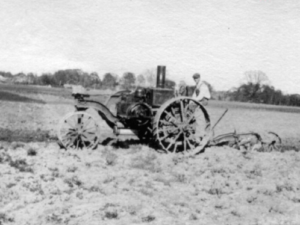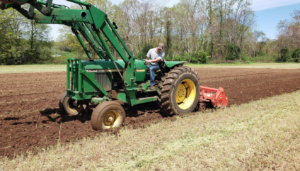 Bishop’s first tractor was an International Harvester 1916 Mogul 8-16. This one cylinder, 5000 pound, metal wheeled 8 HP kerosene powered tractor cost $675. Young Charles Remington Bishop, age 18, posed for this photo during a break from plowing part of the 14 acre field which we still farm 150 years later. This field is on Dunk Rock Rd adjacent to ‘Bishop’s Ice Pond’ where ice was harvested until the 1938 Hurricane destroyed the Ice House. 6 Generations later on this same land, and 13 generations since John Bishop arrived with Rev. Henry Whitfield and settled Guilford, we’re proud to be stewards of this land where today we grow raspberries, asparagus and a wide variety of vegetables. The Mogul tractor and it’s implements to prep our land are long gone, but not our drive and zeal to farm our land.
Bishop’s first tractor was an International Harvester 1916 Mogul 8-16. This one cylinder, 5000 pound, metal wheeled 8 HP kerosene powered tractor cost $675. Young Charles Remington Bishop, age 18, posed for this photo during a break from plowing part of the 14 acre field which we still farm 150 years later. This field is on Dunk Rock Rd adjacent to ‘Bishop’s Ice Pond’ where ice was harvested until the 1938 Hurricane destroyed the Ice House. 6 Generations later on this same land, and 13 generations since John Bishop arrived with Rev. Henry Whitfield and settled Guilford, we’re proud to be stewards of this land where today we grow raspberries, asparagus and a wide variety of vegetables. The Mogul tractor and it’s implements to prep our land are long gone, but not our drive and zeal to farm our land.

While a relatively large farm in CT, we are small by comparison to our farming friends outside of New England. We use a variety of methods to enhance conservation and minimize wind and water erosion. For most vegetables, we rototill, then create a ‘plant-bed’ by laying down biodegradable plastic with drip-tube irrigation under the plastic to deliver water to the root zone. This uses less water than overhead irrigation, saving pumping energy, labor and money. Another technique we use is a hillside cultivator for strawberries, raspberries and vegetables pictured here. Land on slopes is rarely disturbed, and done in strips so sod remains between the rows where we will be planting young trees. Soil loss occurs when it is embedded in the leaves and roots of harvested plants, tracked away by equipment and humans, or carried away by wind and rain.
 We work to counteract the natural loss of soil by growing cover crops, such as legumes and mustard, as well as following other farming BMPs (best management practices). Adding organic matter back into the soil is important to allow for oxygen and water to reach the root zone, excess rains to flow through, and allow earthworms to till the soil. Mustards with high glucosinolate levels are good for biofumigation to help control nematodes, and they look pretty too!
We work to counteract the natural loss of soil by growing cover crops, such as legumes and mustard, as well as following other farming BMPs (best management practices). Adding organic matter back into the soil is important to allow for oxygen and water to reach the root zone, excess rains to flow through, and allow earthworms to till the soil. Mustards with high glucosinolate levels are good for biofumigation to help control nematodes, and they look pretty too!
So the next time you see one of our John Deere Green tractors at work, think of our monster 1916 Mogel that had less power then today’s ‘weekend warrior’ lawn tractors. Then reflect upon the cycle of life that farmers live out with their crops: “a time to be born, and a time to die; a time to plant, and a time to pluck up what is planted” from Ecclesiastes 3:2. Rebirth of our crops means food on your table.
